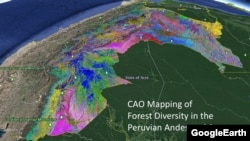Rainforests, it turns out, are not created equal.
Take the Amazon rainforest, an area that covers about 7 million square kilometers. It lies within the borders of nine South American countries: Brazil, with 60 percent of the rainforest, Peru, Colombia, Venezuela, Ecuador, Bolivia, Guyana, Suriname and French Guiana.
It's not just one giant forest
But within that huge expanse are all kinds of ecological zones, and some of these zones, says Greg Asner, the principal investigator at the Carnegie Airborne Observatory (CAO), are a lot more crowded than others.
"Some forests have many species of trees," he told VOA, "others have few. Many forests are unique from others in terms of their overall species composition..." And all of these different small areas of forest exist within the giant space that is the Amazon Rainforest.
So Asner, using the CAO's signature technique called airborne laser-guided imaging spectroscopy, began to map these different zones from the air.
"By mapping the traits of tropical forests from above," he explains, "we are, for the first time, able to understand how forest composition varies geographically."
The results show up in crazy-looking multicolored maps, with each color representing different kinds of species, different kinds of trees, the different kinds of chemicals they are producing and using, and even the amount of biodiversity, the animal and plant species that live within each zone.
Mapping High Priority Targets
Armed with this information, Asner says decision-makers now have "a first-time way to decide whether any given forest geography is protected well enough or not. If not, then new protections can be put in place to save a given forest from destruction."
The Carnegie team joined with the Peruvian Ministry of Environment (MINAM) on this project. Working together, they were able to "find about [121 million square kilometers] of biologically unique lowland Amazonian forest and [28 thousand square kilometers] of peatland forest in northern Peru that could be conserved, as well as [6,000 square meters] of distinct submontane [foothills] and high Andean forests that are highly threatened."
Asner says the information is a great way for decision-makers to develop a "cost-benefit ratio type analysis." Conservation efforts can be expensive, so armed with this information, government leaders can ensure they are making the most of their conservation dollars by focusing on areas that are the most biologically diverse or unique.
The next step, Asner says, is to take his project global, and to put his eyes even higher in the sky, on orbital satellites.
"The technique we developed and applied to map Peru is ready to go global," Asner said. "We want to put the required instrumentation on an Earth-orbiting satellite, to map the planet every month, which will give the best possible view of how the world's biodiversity is changing, and where to put much needed protections."
It's an ambitious project but the technology, Asner says, is ready. If and when it gets put up in space, it will give conservationists a way to track not just the rainforest, but the world's changing biodiversity.











